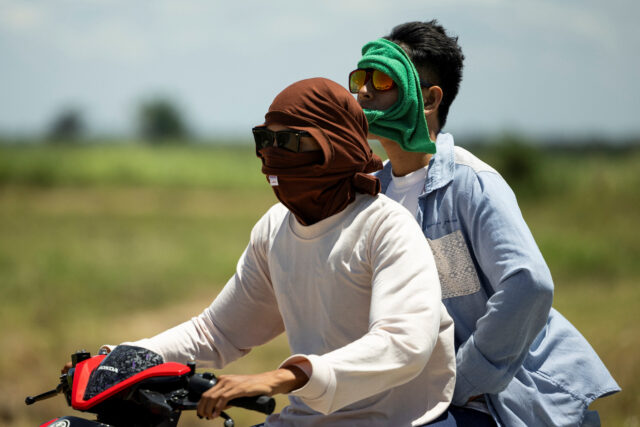As temperatures rise in parts of Asia and North Africa, education has been a casualty. Governments have asked schools to close as a precautionary measure, leading to learning gaps worldwide.
Hena Khan, a grade nine student in Dhaka, has struggled to focus on her studies this week as temperatures surpassed 43 degrees Celsius (109 degrees Fahrenheit) in the Bangladesh capital.
“There is no real education in schools in this punishing heat,” she said. “Teachers can’t teach, students can’t concentrate. Rather, our lives are at risk.”
Khan is one of more than 40 million students who have been shut out of classrooms in recent weeks as heat waves have forced school closures in parts of Asia and North Africa.
As the climate warms due to the burning of fossil fuels, heatwaves are lasting longer and reaching greater peaks.
In turn, government authorities and public health experts across the world are increasingly grappling with whether to keep students learning in hot classrooms, or encourage them to stay home and keep cool.
Either decision has consequences. About 17% of the world’s school-aged children are already out of school, according to United Nations data, but the proportion is much larger in developing countries with nearly a third of sub-Saharan Africa’s children out of school compared to just 3% in North America.
Child test scores in the developing world also lag developed countries.
Experts informed Reuters that heat could intensify inequalities, potentially expanding educational disparities between developing tropical nations and more developed countries, as well as among affluent and less affluent districts within wealthy nations. Additionally, they noted that exposing children to excessively hot school environments could lead to illness.
South Sudan already this year closed its schools to some 2.2 million students in late March when temperatures soared to 45 degrees Celsius (113 Fahrenheit). Thousands of schools in the Philippines and in India followed suit in late April, closing classrooms to more than 10 million students.
On Wednesday, Cambodia ordered all public schools to slash two hours off the school day to avoid peak heat at midday.
Meanwhile, Bangladesh has wavered between opening and closing schools for some 33 million students amid pressure to prepare pupils for exams — even as temperatures climb to dangerous levels.
Many Bangladeshi schools “don’t have fans, the ventilation is not good, and they might have tin roofing which does not provide good insulation”, said Shumon Sengupta, Bangladesh country director for nonprofit Save the Children.
HOT HEADS
Even if students continue attending classes during heatwaves, their education is likely to suffer. High temperatures slow down the brain’s cognitive functions, lowering pupils’ ability to retain and process information.
U.S. high schoolers, one 2020 study found, performed worse on standardised tests if they were exposed to higher temperatures in the year leading up to the exam.
The research, published in the American Economic Journal, found that a 0.55C (1F) warmer school year reduced that year’s learning by 1%. Much of that impact disappeared in schools that had air conditioning, said study co-author Josh Goodman, an economist at Boston University.
Between 40% and 60% of U.S. schools are thought to have at least partial air conditioning, according to various surveys.
Schools without it are often found in poorer districts which already trail their wealthier counterparts academically.
Goodman and his colleagues found similar learning outcomes tied to heat when they looked at standardised test data in other countries. “When (students in) these places experience a year with more heat, they appear to have learned less,” he said.
Other research suggests excessive heat in the tropics can also impact a child’s education even before birth.
Children in Southeast Asia exposed to higher-than-average temperatures in utero and early in life obtained fewer years of schooling later in life, a 2019 study in the Proceedings of the National Academy of Sciences found.
All of this is worrying, Goodman said, because as the world warms, already hot countries shifting to an extremely hot climate will suffer more than temperate countries.
“Climate change will widen the learning gaps between hot and cool countries,” Goodman said.
Some developed countries are trying to address the issue.
In March, the U.S. Agency for International Development (USAID) announced it would build 30 heat-resilient schools in Jordan by 2026 “to address the projected increase in extreme heat days in Jordan”, a USAID spokesperson said.
USAID revealed plans, not previously disclosed, to allocate $8.17 million towards equipping schools with passive cooling systems and air conditioning. This investment aims to maintain school operations despite rising temperatures. In the U.S., there has been an increase in the number of school closures due to extreme heat, although few countries systematically monitor this data.
U.S. schools are now cancelling class for an average of six to seven school days each year for heat, compared with about three to four days a decade ago, said Paul Chinowsky, a civil engineer who led a 2021 study on schools and rising temperatures for the firm Resilient Analytics.
In Bangladesh last year, schools were closed for 6-7 days, said Save the Children’s Sengupta. “But this year, they are saying it might be closed for 3 to 4 weeks,” he said, as May is often the hottest month in South Asia.
With Inputs From Reuters
















